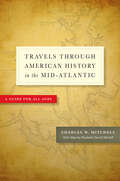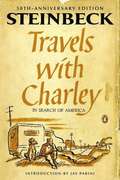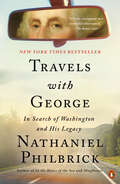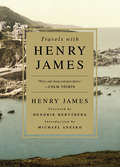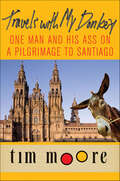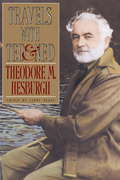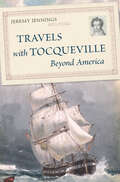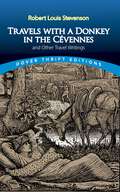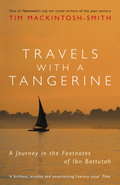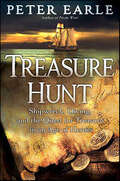- Table View
- List View
Travels through American History in the Mid-Atlantic: A Guide for All Ages
by Charles W. MitchellExplore the historic landscape of the mid-Atlantic with this family-friendly guide.Winner of the SATW Category 119: Guidebook Gold Winner of the Society of American Travel Writers FoundationWinner of the Society for American Travel Writers’ Lowell Thomas Travel Journalism 2016 Gold Award in the Guidebook CategoryFew regions of the United States boast as many historically significant sites as the mid-Atlantic. Travels through American History in the Mid-Atlantic brings to life sixteen easily accessible historical destinations in Pennsylvania, Maryland, Washington, D.C., the Potomac Valley, and Virginia. Charles W. Mitchell walked these sites, interviewed historians and rangers, and read the letters and diaries of the men and women who witnessed—and at times made—history. He reveals in vivid prose the ways in which war, terrain, weather, and illness have shaped the American narrative. Each attraction, reenactment, and interactive exhibit in the book is described through the lens of the American experience, beginning in the colonial and revolutionary eras, continuing through the War of 1812, and ending with the Civil War. Mitchell contrasts the ornate decor of Philadelphia’s Independence Hall, for example, with the passionate debates that led to the Declaration of Independence, and the tranquil beauty of today’s Harpers Ferry with the trauma its citizens endured during the Civil War, when the town six times fell to opposing forces. Excerpts from eyewitness accounts further humanize key moments in the national story. Hand-drawn maps evoke the historical era by depicting the natural features that so often affected the course of events. This engaging blend of history and travel will appeal to visiting tourists, area residents seeking weekend diversions, history buffs, and armchair travelers.
Travels with Alice
by Calvin TrillinThis delightful book collects Calvin Trillin's accounts of his trips to Europe with his wife, Alice, and their two daughters. In Taormina, Sicily, they cheerfully disagree with Mrs. Tweedie's 1904 assertion that the beautiful town "is being spoilt," and skip the Grand Tour in favor of swimming holes, table soccer, and taureaux piscine. In Paris, they spend a day on the Champs-Elysées comparing Freetime's "le Hitburger" to McDonald's Big Mac. In Spain, Trillin wonders whether he will run out of Spanish "the way someone might run out of flour or eggs." Filled with Trillin's characteristic humor, "Travels with Alice" is the perfect book for summer travelers.
Travels with Charley in Search of America
by John Steinbeck Jay PariniThe 50th anniversary deluxe edition of Travels with Charley in Search of America features an updated introduction by Jay Parini and first edition cover art and illustrated maps of Steinbeck's route by Don Freeman. <P> In September 1960, John Steinbeck embarked on a journey across America. He felt that he might have lost touch with the country, with its speech, the smell of its grass and trees, its color and quality of light, the pulse of its people. To reassure himself, he set out on a voyage of rediscovery of the American identity, accompanied by a distinguished French poodle named Charley; and riding in a three-quarter-ton pickup truck named Rocinante. <P> His course took him through almost forty states: northward from Long Island to Maine; through the Midwest to Chicago; onward by way of Minnesota, North Dakota, Montana (with which he fell in love), and Idaho to Seattle, south to San Francisco and his birthplace, Salinas; eastward through the Mojave, New Mexico, Arizona, to the vast hospitality of Texas, to New Orleans and a shocking drama of desegregation; finally, on the last leg, through Alabama, Virginia, Pennsylvania, and New Jersey to New York. Travels with Charley in Search of America is an intimate look at one of America's most beloved writers in the later years of his life-a self-portrait of a man who never wrote an explicit autobiography. Written during a time of upheaval and racial tension in the South-which Steinbeck witnessed firsthand-Travels with Charley is a stunning evocation of America on the eve of a tumultuous decade. .
Travels with Charley in Search of America: In Search Of America (Penguin Audio Classics Ser.)
by John SteinbeckAn intimate journey across and in search of America, as told by one of its most beloved writers, in a deluxe centennial edition In September 1960, John Steinbeck embarked on a journey across America. He felt that he might have lost touch with the country, with its speech, the smell of its grass and trees, its color and quality of light, the pulse of its people. To reassure himself, he set out on a voyage of rediscovery of the American identity, accompanied by a distinguished French poodle named Charley; and riding in a three-quarter-ton pickup truck named Rocinante. His course took him through almost forty states: northward from Long Island to Maine; through the Midwest to Chicago; onward by way of Minnesota, North Dakota, Montana (with which he fell in love), and Idaho to Seattle, south to San Francisco and his birthplace, Salinas; eastward through the Mojave, New Mexico, Arizona, to the vast hospitality of Texas, to New Orleans and a shocking drama of desegregation; finally, on the last leg, through Alabama, Virginia, Pennsylvania, and New Jersey to New York. Travels with Charley in Search of America is an intimate look at one of America's most beloved writers in the later years of his life--a self-portrait of a man who never wrote an explicit autobiography. Written during a time of upheaval and racial tension in the South--which Steinbeck witnessed firsthand--Travels with Charley is a stunning evocation of America on the eve of a tumultuous decade. This Penguin Classics Deluxe Edition also features French flaps and deckle-edged paper.For more than sixty-five years, Penguin has been the leading publisher of classic literature in the English-speaking world. With more than 1,500 titles, Penguin Classics represents a global bookshelf of the best works throughout history and across genres and disciplines. Readers trust the series to provide authoritative texts enhanced by introductions and notes by distinguished scholars and contemporary authors, as well as up-to-date translations by award-winning translators.From the Trade Paperback edition.
Travels with Charley: In Search of America
by John SteinbeckAn intimate journey across America, as told by one of its most beloved writers<P> To hear the speech of the real America, to smell the grass and the trees, to see the colors and the light—these were John Steinbeck's goals as he set out, at the age of fifty-eight, to rediscover the country he had been writing about for so many years.<P> With Charley, his French poodle, Steinbeck drives the interstates and the country roads, dines with truckers, encounters bears at Yellowstone and old friends in San Francisco. Along the way he reflects on the American character, racial hostility, the particular form of American loneliness he finds almost everywhere, and the unexpected kindness of strangers.
Travels with Epicurus
by Daniel KleinOne of the bestselling authors of Plato and a Platypus travels to Greece with a suitcase full of philosophy books, seeking the best way to achieve a fulfilling old age Daniel Klein journeys to the Greek island Hydra to discover the secrets of aging happily. Drawing on the lives of his Greek friends, as well as philosophers ranging from Epicurus to Sartre, Klein learns to appreciate old age as a distinct and extraordinarily valuable stage of life. He uncovers simple pleasures that are uniquely available late in life, as well as headier pleasures that only a mature mind can fully appreciate. A travel book, a witty and accessible meditation, and an optimistic guide to living well, Travels with Epicurus is a delightful jaunt to the Aegean and through the terrain of old age led by a droll philosopher. A perfect gift book for the holidays, this little treasure is sure to please longtime fans of Plato and a Platypus Walk into a Bar and garner new ones, young and old .
Travels with George: In Search of Washington and His Legacy
by Nathaniel PhilbrickDoes George Washington still matter? Bestselling author Nathaniel Philbrick argues for Washington's unique contribution to the forging of America by retracing his journey as a new president through all thirteen former colonies, which were now an unsure nation. Travels with George marks a new first-person voice for Philbrick, weaving history and personal reflection into a single narrative. <P><P>When George Washington became president in 1789, the United States of America was still a loose and quarrelsome confederation and a tentative political experiment. Washington undertook a tour of the ex-colonies to talk to ordinary citizens about his new government, and to imbue in them the idea of being one thing--Americans. <P><P>In the fall of 2018, Nathaniel Philbrick embarked on his own journey into what Washington called "the infant woody country" to see for himself what America had become in the 229 years since. Writing in a thoughtful first person about his own adventures with his wife Melissa and their dog Dora, Philbrick follows Washington's presidential excursions: from Mount Vernon to the new capital in New York; a month-long tour of Connecticut, Massachusetts, New Hampshire, and Rhode Island; a venture onto Long Island and eventually across Georgia, South Carolina, and North Carolina. The narrative moves smoothly between the eighteenth and twenty-first centuries as we see the country through both Washington's and Philbrick's eyes. <P><P>Written at a moment when America's founding figures are under increasing scrutiny, Travels with George grapples bluntly and honestly with Washington's legacy as a man of the people, a reluctant president, and a plantation owner who held people in slavery. At historic houses and landmarks, Philbrick reports on the reinterpretations at work as he meets reenactors, tour guides, and other keepers of history's flame. He paints a picture of eighteenth century America as divided and fraught as it is today, and he comes to understand how Washington compelled, enticed, stood up to, and listened to the many different people he met along the way--and how his all-consuming belief in the Union helped to forge a nation. <P><P><b>A New York Times Best Seller</b>
Travels with Henry James
by Henry James Michael Anesko Hendrik Hertzberg"To travel with James in these pages is to take an unhurried vacation with a thoroughly seasoned, supremely cultivated, acutely intelligent companion. Our guide is a curious, engaged observer not only of landscapes and streets and cathedrals but also of paintings and plays and the characteristics—national, social, and individual—of the people we encounter at his side. This is a book to be read slowly, the better to absorb its sights and sounds, its insights and reflections.” —from the foreword by Hendrik HertzbergBrimming with charm, wit, and biting criticism, this new collection of travel essays reintroduces the iconic novelist Henry James as a formidable travel companion. Whether for a trip to Lake George or an afternoon visit to an art exhibit in Paris, James will delight readers with his insights and make them feel nostalgic for places they've never been.
Travels with My Donkey: One Man and His Ass on a Pilgrimage to Santiago
by Tim Moore"'A donkey?' blurted my family as one. For a moment it didn't seem they'd ever be able to list all the reasons that made this so entertainingly ludicrous. . . .Yes, I'd never ridden a donkey on a beach or petted one at a city farm, never even pinned a cardboard tail to one's throat after the cake and ice cream....A donkey would be my hairy-coated hair shirt, making my pilgrimage to Santiago de Compostela a truer test of the will, a trial."With these words, having no knowledge of Spanish and even less about the care and feeding of donkeys, Tim Moore, Britain's indefatigable traveling Everyman, sets out on a pilgrimage to the cathedral at Santiago de Compostela with a donkey named Shinto as his companion. Armed only with the Codex Calixtinus, a twelfth-century handbook to the route, and expert advice on donkey management from Robert Louis Stevenson, Moore and his four-legged companion travel the ancient five-hundred-mile route from St. Jean Pied-de-Port, on the French side of the Pyrenees, to the cathedral at Santiago de Compostela, which houses the remains of Spain's patron saint, St. James. Over sun-scorched highways, precipitous bridges, dirt paths shaded by leafy trees, and vineyards occasionally lashed by downpours, Moore and Shinto pass through some of the oldest towns and cities in northern Spain in colorful company, both past and present. Pilgrims real and imagined have traveled this route throughout the ages, a diverse cast of wayfarers spanning Charlemagne, St. Francis of Assisi, Chaucer's Wife of Bath, and New Age diva, Shirley MacLaine. Moore's present-day companions are no less florid or poignant. Clearly more interested in Shinto than in Moore, their fellow walkers are an assortment of devout Christian pilgrims, New Age spirituality seekers, travelers grieving over a lost love affair, Baby Boomers contemplating the advent of middle age, and John Q. Public just out for a cheap, boozy sun-drenched outdoor holiday. As Moore pushes, pulls, wheedles, cajoles, and threatens Shinto across Spain toward the crypt of St. James in a quest to find the spiritual pilgrim within, the duo overnights in the bedrooms, dormitories, and---for Shinto---adjacent grassy fields of northern Spain's hostels, inns, convents, seminaries, and farmhouses. Shinto, a donkey with a finely honed talent for relieving himself at the most inopportune moments, has better luck in the search for his next meal than Moore does in finding his inner St. Francis. Undaunted, however, Man and Beast finally arrive at the cathedral and a successful end to their journey. For readers who delighted in his earlier books, Travels with My Donkey is the next hilarious chapter in the travels of Tim Moore, a book that keeps the bones of St. James rattling till this day.
Travels with Ted & Ned
by Theodore M. HesburghThe warm and moving story of one of the greatest religious and secular leaders of our time.
Travels with Tocqueville Beyond America
by Jeremy JenningsA revelatory intellectual biography of Tocqueville, told through his wide-ranging travels—most of them, aside from his journey to America, barely known.It might be the most famous journey in the history of political thought: in 1831, Alexis de Tocqueville sailed from France to the United States, spent nine months touring and observing the political culture of the fledgling republic, and produced the classic Democracy in America.But the United States was just one of the many places documented by the inveterate traveler. Jeremy Jennings follows Tocqueville’s voyages—by sailing ship, stagecoach, horseback, train, and foot—across Europe, North Africa, and of course North America. Along the way, Jennings reveals underappreciated aspects of Tocqueville’s character and sheds new light on the depth and range of his political and cultural commentary.Despite recurrent ill health and ever-growing political responsibilities, Tocqueville never stopped moving or learning. He wanted to understand what made political communities tick, what elite and popular mores they rested on, and how they were adjusting to rapid social and economic change—the rise of democracy and the Industrial Revolution, to be sure, but also the expansion of empire and the emergence of socialism. He lauded the orderly, Catholic-dominated society of Quebec; presciently diagnosed the boisterous but dangerously chauvinistic politics of Germany; considered England the freest and most unequal place on Earth; deplored the poverty he saw in Ireland; and championed French colonial settlement in Algeria.Drawing on correspondence, published writings, speeches, and the recollections of contemporaries, Travels with Tocqueville Beyond America is a panoramic combination of biography, history, and political theory that fully reflects the complex, restless mind at its center.
Travels with a Donkey in the Cévennes: and Other Travel Writings (Dover Thrift Editions)
by Robert Louis StevensonTemperament and poor health motivated Robert Louis Stevenson to travel widely throughout his short life, and before he was celebrated as the author of Treasure Island, A Child's Garden of Verses, and other immortal works, he was known for his travelogues. This collection presents some of his finest writing in that vein, starting with "An Inland Voyage." This 1878 chronicle of a canoe journey through Belgium and France charmingly captures the European villages and townspeople of a bygone era. Other selections include "Travels with a Donkey in the Cévennes," a humorous account of a mountain trek, and "Forest Notes," a meditation on nature based on visits to the Forest of Fontainebleau near Paris and adjacent artists' colonies. These early writings offer captivating insights into Stevenson's bohemian nature and the wanderlust that sent him from his native Scotland to journeys around the world.
Travels with a Tangerine: A Journey In The Footnotes Of Ibn Battutah
by Tim Mackintosh-SmithIbn Battutah set out in 1325 from his native Tangier on the pilgrimage to Mecca. By the time he returned twenty-nine years later, he had visited most of the known world, travelling three times the distance Marco Polo covered. Spiritual backpacker, social climber, temporary hermit and failed ambassador, he braved brigands, blisters and his own prejudices. The outcome was a monumental travel classic. Captivated by this indefatigable man, award-winning travel writer Tim Mackintosh-Smith set out on his own eventful journey, retracing the Moroccan's eccentric trip from Tangier to Constantinople. Tim proves himself a perfect companion to this distant traveller, and the result is an amazing blend of personalities, history and contemporary observation.
Travels with a Tangerine: A Journey in the Footnotes of Ibn Battutah
by Tim Mackintosh-SmithIbn Battutah set out in 1325 from his native Tangier on the pilgrimage to Mecca. By the time he returned twenty-nine years later, he had visited most of the known world, travelling three times the distance Marco Polo covered. Spiritual backpacker, social climber, temporary hermit and failed ambassador, he braved brigands, blisters and his own prejudices. The outcome was a monumental travel classic. Captivated by this indefatigable man, award-winning travel writer Tim Mackintosh-Smith set out on his own eventful journey, retracing the Moroccan's eccentric trip from Tangier to Constantinople. Tim proves himself a perfect companion to this distant traveller, and the result is an amazing blend of personalities, history and contemporary observation.
Travels with my Daughter
by Niema Ash"You could say I had an unconventional upbringing. At the age of four, I was sharing my bedroom with Bob Dylan, and by the time I was fifteen, I had been taken out of school to go traveling and was smoking joints with my mother."Some may be shocked at the adventures mother and daughter share, but everyone will admire Niema’s celebration of travel, motherhood, and life itself, as this honest and often humourous account describes how she copes with:The overwhelming desire to travel, which conflicts with the responsibilites of motherhood.Finding the confidence to believe in herself and her instincts.Being a single mother in the sixties while mixing with some of the most talented poets and musicians of our time, including Bob Dylan, Leonard Cohen, Irving Layton, Seamus Heaney, and Joni Mitchell.Developing a unique mother-daughter bond that many only dream about.This book will touch a hidden nerve in everyone who reads it as it turns a world of convention and protocol upside-down!
Travels: Collected Writings, 1950-1993
by Paul Bowles"Bowles is at his best when writing about places. He can evoke a place with a few sure strokes."--New York Times"His work is art. At his best, Bowles has no peer."--TimeTravels is a thrilling anthology of the travel writings of Paul Bowles, author of the era-defining post-war novel The Sheltering Sky. The acclaimed essays in Travel--never before collected in a single volume--span more than sixty years and range from Bowles's early days in Paris to his time spent in Ceylon, Thailand, Kenya, and his expatriate life in Morocco. Insightful, exciting, and evocative, featuring original photographs throughout, Travels is a stunning collection of rarely seen shorter works--a showcase of the literary artistry of one of the truly great American writers of the twentieth century.
Travels: The Farther You Go, The Closer You Get (Vintage Departures Ser.)
by Michael CrichtonFrom the bestselling author of Jurassic Park, Timeline, and Sphere comes a deeply personal memoir full of fascinating adventures as he travels everywhere from the Mayan pyramids to Kilimanjaro. Fueled by a powerful curiosity--and by a need to see, feel, and hear, firsthand and close-up--Michael Crichton's journeys have carried him into worlds diverse and compelling--swimming with mud sharks in Tahiti, tracking wild animals through the jungle of Rwanda. This is a record of those travels--an exhilarating quest across the familiar and exotic frontiers of the outer world, a determined odyssey into the unfathomable, spiritual depths of the inner world. It is an adventure of risk and rejuvenation, terror and wonder, as exciting as Michael Crichton's many masterful and widely heralded works of fiction.
Travesía A África
by Peter Boehm Inés Fernández TaboadaPublicado en alemán, español, inglés e italiano. "Travesía a África" ha estado durante casi un año en el Top 10 de Aventuras y Viajes de Amazon Alemania.Peter Boehm atravesó África en coches a mil por hora, buses destartalados y trenes desvencijados. Casi seis meses, más de 10 000 kilómetros, a través de nueve países: Somalia, Yibuti, Etiopía, Sudán, Chad, Nigeria, Niger, Malí y Senegal. El viaje fue vertiginoso y enervante, pero nunca aburrido. La gente que conoció era emocionante, rara y conmovedora, pero nunca le dejaban indiferente. En Somalia, Peter Boehm retrató a psiquiatras que tomaban por locos a todos los campesinos, así como a los mismos somalíes e incluso, al final, ¡hasta al propio autor! En Sudán conoció a médicos que devolvían la virginidad a las mujeres; en Chad, a niños de la calle que, al verle, ya le esperaban con sus maletas preparadas para emprender su viaje a Alemania; en Malí, a curanderos tradicionales que eran al mismo tiempo médicos de cabecera y consejeros sentimentales; en Nigeria, a gobernantes tradicionales ante los que sus súbditos se tiraban al suelo y a jueces islámicos que disfrutaban de las flagelaciones que sentenciaban como de un buen vino. Además Peter Boehm ha retratado las idas y venidas de un europeo en África. El tono de Peter Boehm es lacónico y libre de cualquier sensiblería. Nunca han leído nada igual sobre África.
Trawler
by Redmond O'HanlonHaving survived Borneo, Amazonia, and the Congo, the indefatigable Redmond O'Hanlon sets off on his next adventure: his own perfect storm, in the wild waters off the northern tip of Scotland. Equipped with a fancy Nikon, an excessive supply of socks, and no seamanship whatsoever, O'Hanlon joins the commercial fishing crew of the Norlantean, a deep-sea trawler, to stock a bottomless hull with their catch, even as a hurricane roars around them. Rich in oceanography, marine biology, and uproarious humor, Trawler is Redmond O'Hanlon at his finest.
Treading Grapes: Walking Through The Vineyards Of Tuscany
by Rosemary GeorgeTuscany offers some of the most spectacular scenery in Europe. The unique combination of cypress trees and olive groves mingling with vineyards and woods on undulating hillsides is enchanting. With villages and villas at every turn, what better way to explore the countryside than on foot? Over fifteen months of changing seasons Rosemary George did just that, visiting wine producers along the way, observing and savouring the local colour and the idiosyncrasies of a myriad of winemakers. Each chapter will feature a walk through a wine region and include advice on the key estates, places to visit and favourite restaurants. Chianti, which covers the heart of Tuscany, is the wine we all know and love, with vineyards in the magical hills around Florence and Siena, and the medieval cities of Arezzo and Pisa. However, the face of Tuscan viticulture has changed enormously in recent years with the development of the vineyards of the Maremma, bringing a host of new wines. Treading Grapes charts this wonderful renaissance of Tuscan wines, not just of Chianti, but also of the newer prestigious names such as Sassicaia and Ornellaia in the rising area of Bolgheri. It also covers the old-established wines of Brunello di Montalcino and Vino Nobile di Montepulciano, and several others, not least the island of Elba. It will be enjoyed by wine enthusiasts and armchair travellers alike.
Treasure Hunt: Shipwreck, Diving, and the Quest for Treasure in an Age of Heroes
by Peter Earle"A remarkable book, in which a very wide spectrum of human behavior is on show---from colossal gullibility on the one hand, to extraordinary ingenuity and determination on the other." —The Daily Telegraph (UK)Treasure Hunt is the story of an obsession. Rumors of Spanish treasure, or gold and silver at the bottom of the sea, have been a part of maritime lore for centuries. In 1687, Captain William Phips brought back to port an incredible cargo---nearly forty tons of silver and gold---the treasure of the Spanish galleon Concepción, wrecked over forty years before on a coral reef in the middle of the ocean. The unimaginable had become real, and the great treasure-hunting boom had begun. Soon after Phips's success, there were numerous expeditions that meant to emulate his stunning achievement. During that same time there was also a boom in the invention of crude and often very dangerous diving equipment. Many of these new projects were promoted on the infant stock market, where gambling and treasure hunting became closely connected with the birth of modern capitalism. By the eighteenth and nineteenth centuries, treasure hunting had become a professional occupation, with a new breed of diver emerging. Much of their time was spent salvaging the wrecks of English and Dutch East-Indiamen carrying treasure to finance business in Asia. Ever since, men have been prepared to risk life and fortune in the search for underwater riches. The author of numerous books of maritime history, including The Pirate Wars and The Sack of Panamá, world-renowned historian Peter Earle returns with an extraordinary and little-known history---of outstanding bravery, of exceptional recklessness, and above all, of the unquenchable lust for treasure.
Treasure Hunters: The Ultimate Quest (Treasure Hunters #8)
by James Patterson Chris GrabensteinDodge missiles, map undersea caves, outrun secret agents, and uncover the ultimate treasure? That&’s a day in the life of the Kidds! The Kidd family is on an exciting new mission: use the augmented reality gear their parents created to uncover long-lost treasure. But then their ship, The Lost, explodes in a ball of fire! Now Bick, Beck, Tommy, and Storm are stranded on a raft in the Mediterranean Sea, and their parents have been kidnapped by maniacal treasure hunters. It&’s up to the Kidd siblings to follow clues around the globe to uncover an ancient treasure and save their parents . . . before they lose everything!
Treasure Island
by Robert Louis Stevenson G. S. FraserUnrivaled in literature, Stevenson's Treasure Island is among the most delightful adventure romances of all time. From young Jim Hawkins' first encounter with an old buccaneer and his treasure map to the final daring skirmish with the treacherous pirate Long John Silver, this classic work enchants and fuels the imagination with beautiful illustrations. Copyright © Libri GmbH. All rights reserved.
Treasure Island (Core Classics Series #3)
by Robert Louis Stevenson Michael J. MarshallFor sheer storytelling delight and pure adventure, Treasure Island has never been surpassed. From young Jim Hawkins’s first encounter with the sinister beggar Pew to the climactic battle with the most memorable villain in literature, Long John Silver, this novel has fired readers’ imaginations for generations. A rousing tale of treachery, greed, and daring, Treasure Island continues to enthrall readers of all ages.
